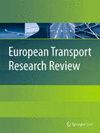数据驱动的优先排序框架,以减轻地铁线路运营期间维护工作对乘客的影响
IF 4.2
3区 工程技术
Q1 TRANSPORTATION
引用次数: 0
摘要
人工智能(AI)技术的应用可显著改善铁路部门的各个方面。考虑到资产管理和维护,人工智能可以改进数据分析和资产状态预测及决策过程,促进预测性和规范性维护战略。规范性方法应能预测未来情景并提出行动方案。然而,铁路资产管理的决策往往基于传统的以资产为导向的方法,将资产本身的功能作为主要的关键绩效指标(KPI),而以用户为导向的方法可以提高服务水平方面的绩效。本文旨在将乘客的观点纳入资产管理决策过程,以减轻服务中断可能对最终用户造成的影响。本文开发了一个数据驱动的优先排序框架,以根据资产状态和关键性确定维护干预措施的优先排序。具体而言,提出了一种三步法,重点是分析乘客数据以评估故障对服务的影响,分析警报和异常情况以评估资产状态,以及提出维护干预建议。建议的方法被应用于意大利米兰市地铁 M5 号线的维护。结果表明,所提出的方法非常有用,可以支持基础设施管理人员和维护操作人员就维护活动的优先级做出决策,降低关键故障和服务中断的风险。本文章由计算机程序翻译,如有差异,请以英文原文为准。
A data-driven prioritisation framework to mitigate maintenance impact on passengers during metro line operation
The application of artificial intelligence (AI) techniques may lead to significant improvements in different aspects of rail sector. Considering asset management and maintenance, AI can improve data analysis and asset status forecasting and decision-making processes, fostering predictive and prescriptive maintenance strategies. A prescriptive approach should be able to predict future scenarios as well as to suggest a course of actions. Nevertheless, the decision-making in rail asset management is often based on the classical asset-oriented approach, concentrating on the function of the asset itself as a main key performance indicator (KPI), whereas a user-oriented approach could lead to improved performance in terms of level of service. This paper is aimed at integrating the passengers’ perspective in the decision-making process for asset management to mitigate the impact that service interruptions may have on the final users. A data-driven prioritisation framework is developed to prioritise maintenance interventions taking into account asset status and criticality. In particular, a three-step approach is proposed, which focuses on the analysis of passenger data to evaluate the failure impact on the service, the analysis of alarms and anomalies to evaluate the asset status, and the suggestion of maintenance interventions. The proposed approach is applied to the maintenance of the metro line M5 in the Italian city of Milan. Results show the usefulness of the proposed approach to support infrastructure managers and maintenance operators in making decisions regarding the priority of maintenance activities, reducing the risk of critical failures and service interruptions.
求助全文
通过发布文献求助,成功后即可免费获取论文全文。
去求助
来源期刊

European Transport Research Review
Engineering-Mechanical Engineering
CiteScore
8.60
自引率
4.70%
发文量
49
审稿时长
13 weeks
期刊介绍:
European Transport Research Review (ETRR) is a peer-reviewed open access journal publishing original high-quality scholarly research and developments in areas related to transportation science, technologies, policy and practice. Established in 2008 by the European Conference of Transport Research Institutes (ECTRI), the Journal provides researchers and practitioners around the world with an authoritative forum for the dissemination and critical discussion of new ideas and methodologies that originate in, or are of special interest to, the European transport research community. The journal is unique in its field, as it covers all modes of transport and addresses both the engineering and the social science perspective, offering a truly multidisciplinary platform for researchers, practitioners, engineers and policymakers. ETRR is aimed at a readership including researchers, practitioners in the design and operation of transportation systems, and policymakers at the international, national, regional and local levels.
 求助内容:
求助内容: 应助结果提醒方式:
应助结果提醒方式:


